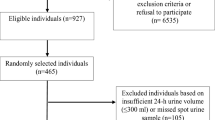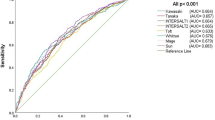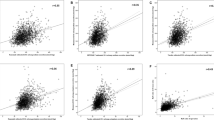Abstract
Background
Measuring sodium excretion in a 24-h urine collection is the most reliable method of estimating salt intake, but it is not applicable to all patients. As an alternative, equations for estimating Na excretion from Japanese by a spot urine sample were created, but they have not been validated in patients with chronic kidney disease (CKD), which are frequently associated with nocturia and medication.
Methods
We enrolled 136 patients with CKD and collected both 24-h urine and the first morning urine. Na excretion was estimated from the first morning urine by Kawasaki’s equation, which was originally used for the second morning urine, and Tanaka’s equation, which is applied for spot urine samples taken at any time from 9 am to 7 pm. We evaluated the two equations for bias, RMSE and accuracy within 30 and 50% of the measured Na excretion.
Results
Bias, RMSE and accuracy within 30% of the estimated Na excretion were 48 ± 69 and 2 ± 69 mmol/day, 84 and 69 mmol/day, and 35 and 49% using Kawasaki’s equation and Tanaka’s equation, respectively. Na excretion in the first morning urine was accurately estimated by Tanaka’s equation, but it was overestimated by Kawasaki’s equation. Nocturia and medication such as diuretics and ACE inhibitor or angiotensin receptor blocker did not affect the accuracy with which Na excretion was estimated by Tanaka’s equation substantially.
Conclusion
Tanaka’s equation for estimating Na excretion from the first morning urine in patients with CKD is accurate enough for use in clinical practice.






Similar content being viewed by others
References
Strazzullo P, D’Elia L, Kandala NB, Cappuccio FP. Salt intake, stroke, and cardiovascular disease: meta-analysis of prospective studies. BMJ. 2009;339:b4567.
Cook NR, Cutler JA, Obarzanek E, Buring JE, Rexrode KM, Kumanyika SK, Appel LJ, Whelton PK. Long term effects of dietary sodium reduction on cardiovascular disease outcomes: observational follow-up of the trials of hypertension prevention (TOHP). BMJ. 2007;334(7599):885–8.
Intersalt Cooperative Research Group. Intersalt: an international study of electrolyte excretion and blood pressure. Results for 24 hour urinary sodium and potassium excretion. BMJ. 1988;297(6644):319–28.
Hooper L, Bartlett C, Davey Smith G, Ebrahim S. Reduced dietary salt for prevention of cardiovascular disease. Cochrane Database Syst Rev. 2003;3:CD003656.
Bibbins-Domingo K, Chertow GM, Coxson PG, Moran A, Lightwood JM, Pletcher MJ, Goldman L. Projected effect of dietary salt reductions on future cardiovascular disease. N Engl J Med. 2010;362(7):590–9.
The Japanese Society of Hypertension. Guidelines (JSH 2009). Chapter 4: lifestyle modifications. Hypertens Res. 2009;32:29–32.
Kawano Y, Tsuchihashi T, Matsuura H, Ando K, Fujita T, Ueshima H. Report of the Working Group for Dietary Salt Reduction of the Japanese Society of Hypertension. 2. Assessment of salt intake in the management of hypertension. Hypertens Res. 2007;30(10):887–93.
Kamata K, Tochikubo O. Estimation of 24-h urinary sodium excretion using lean body mass and overnight urine collected by a pipe-sampling method. J Hypertens. 2002;20(11):2191–7.
Kawasaki T, Itoh K, Uezono K, Sasaki H. A simple method for estimating 24 h urinary sodium and potassium excretion from second morning voiding urine specimen in adults. Clin Exp Pharmacol Physiol. 1993;20(1):7–14.
Kawasaki T, Itoh K, Uezono K, Ogaki T, Yoshimizu Y, Kobayashi S, Osaka T, Ogata M, Dhungel S, Sharma S, et al. Investigation of high salt intake in a Nepalese population with low blood pressure. J Hum Hypertens. 1993;7(2):131–40.
Hashimoto T, Yagami F, Owada M, Sugawara T, Kawamura M. Salt preference according to a questionnaire vs. dietary salt intake estimated by a spot urine method in participants at a health check-up center. Intern Med. 2008;47(5):399–403.
Iseki K, Iseki C, Itoh K, Uezono K, Sanefuji M, Ikemiya Y, Fukiyama K, Kawasaki T. Urinary excretion of sodium and potassium in a screened cohort in Okinawa, Japan. Hypertens Res. 2002;25(5):731–6.
Kawamura M, Kusano Y, Takahashi T, Owada M, Sugawara T. Effectiveness of a spot urine method in evaluating daily salt intake in hypertensive patients taking oral antihypertensive drugs. Hypertens Res. 2006;29(6):397–402.
Tanaka T, Okamura T, Miura K, Kadowaki T, Ueshima H, Nakagawa H, Hashimoto T. A simple method to estimate populational 24-h urinary sodium and potassium excretion using a casual urine specimen. J Hum Hypertens. 2002;16(2):97–103.
Tamaki J, Kikuchi Y, Yoshita K, Takebayashi T, Chiba N, Tanaka T, Okamura T, Kasagi F, Minai J, Ueshima H. Stages of change for salt intake and urinary salt excretion: baseline results from the High-Risk and Population Strategy for Occupational Health Promotion (HIPOP-OHP) study. Hypertens Res. 2004;27(3):157–66.
Fukuda M, Motokawa M, Miyagi S, Sengo K, Muramatsu W, Kato N, Usami T, Yoshida A, Kimura G. Polynocturia in chronic kidney disease is related to natriuresis rather than to water diuresis. Nephrol Dial Transplant. 2006;21:2172–7.
Uzu T, Kimura G. Diuretics shift circadian rhythm of blood pressure from nondipper to dipper in essential hypertension. Circulation. 1999;100(15):1635–8.
Fukuda M, Yamanaka T, Mizuno M, Motokawa M, Shirasawa Y, Miyagi S, Nishio T, Yoshida A, Kimura G. Angiotensin II type 1 receptor blocker, olmesartan, restores nocturnal blood pressure decline by enhancing daytime natriuresis. J Hypertens. 2008;26(3):583–8.
Kawamura M, Hashimoto T, Owada M, Sugawara T. The influence of posture on the estimation of daily salt intake by the second morning urine method. Hypertens Res. 2010;33:505–10.
Ogihara T, Kikuchi K, Matsuoka H, Fujita T, Higaki J, Horiuchi M, Imai Y, Imaizumi T, Ito S, Iwao H, Kario K, Kawano Y, Kim-Mitsuyama S, Kimura G, Matsubara H, Matsuura H, Naruse M, Saito I, Shimada K, Shimamoto K, Suzuki H, Takishita S, Tanahashi N, Tsuchihashi T, Uchiyama M, Ueda S, Ueshima H, Umemura S, Ishimitsu T, Rakugi H. The Japanese Society of Hypertension guidelines for the management of hypertension (JSH 2009). Hypertens Res. 2009;32(1):3–107.
Japanese Society of Nephrology. Evidence-based practice guideline for the treatment of CKD. Clin Exp Nephrol. 2009;13(6):537–66.
Acknowledgments
This study was supported by a grant from the Ministry of Health, Labor and Welfare.
Author information
Authors and Affiliations
Corresponding author
Additional information
A part of this study was presented at ERA-EDTA 2011 at Plague.
An erratum to this article can be found online at http://dx.doi.org/10.1007/s10157-013-0791-y.
About this article
Cite this article
Imai, E., Yasuda, Y., Horio, M. et al. Validation of the equations for estimating daily sodium excretion from spot urine in patients with chronic kidney disease. Clin Exp Nephrol 15, 861–867 (2011). https://doi.org/10.1007/s10157-011-0523-0
Received:
Accepted:
Published:
Issue Date:
DOI: https://doi.org/10.1007/s10157-011-0523-0




